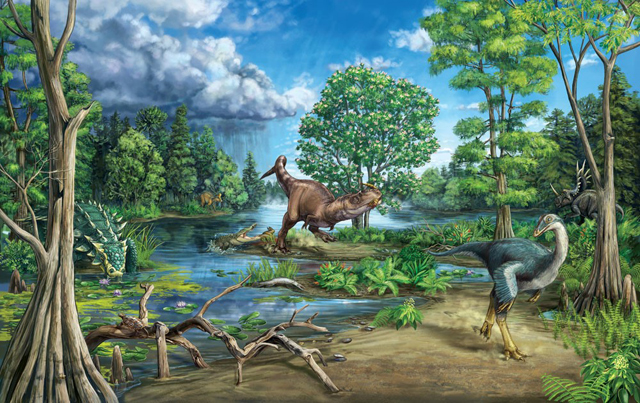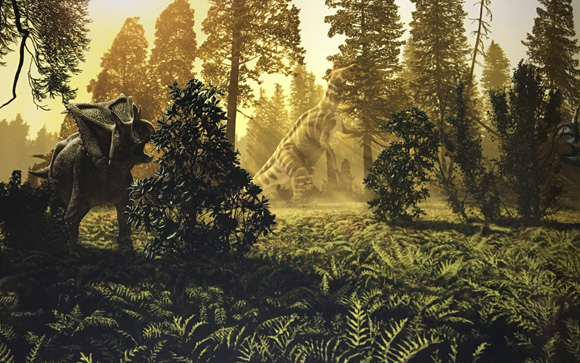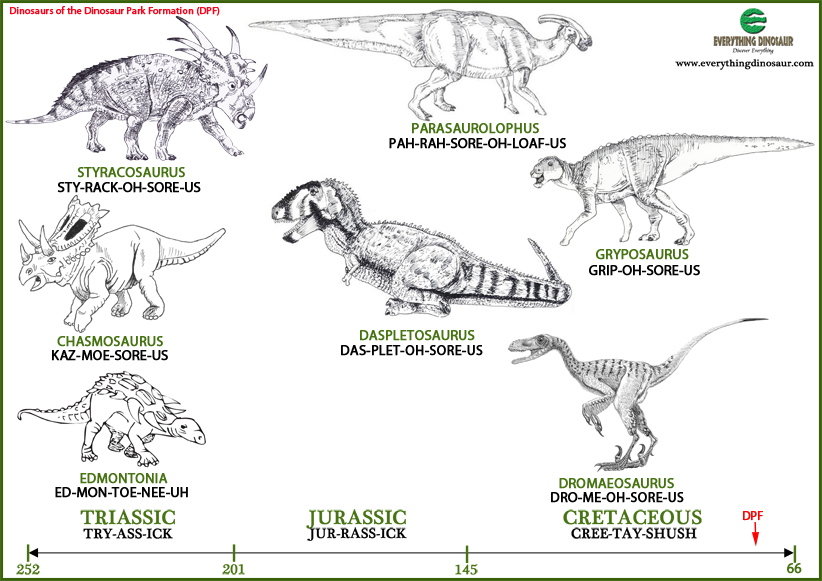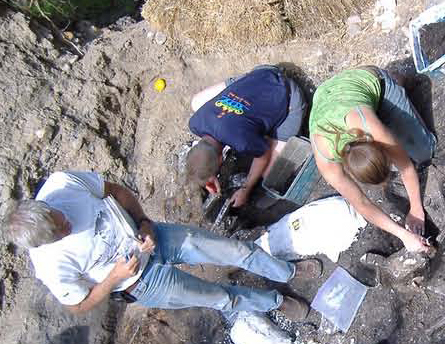Reconstructing a Late Cretaceous Ecosystem
Reconstructing a Dinosaur Dominated Ecosystem
A team of international researchers including scientists from the Royal Ontario Museum (Toronto, Canada), have provided a new perspective on the palaeoenvironment of western North America during the Late Cretaceous. An extensive study mapping stable isotopes identified in fossilised teeth has provided the research team with detailed information on how some dinosaurs co-existed in a floodplain environment on the landmass of Laramidia around 75 million years ago.
Many Different Types of Dinosaur are Associated with the Late Cretaceous of Laramidia

Picture credit: Danielle Dufault (Royal Ontario Museum)
Niche Partitioning in the Dinosauria
Palaeontologists had puzzled over how so many different types of large tetrapod could co-exist together and it had been thought that extensive niche partitioning between species must have been taking place. Niche partitioning describes the natural selection process whereby different species reduce competition amongst themselves by becoming more specialised and adopting specific roles within an ecosystem. They become adapted to a particular niche and by doing this competition between species is reduced.
Niche Partitioning Between Ceratopsids and Hadrosaurids

Picture credit: Julius Csotonyi
Stable Isotope Analysis Used to Reconstruct a Late Cretaceous Ecosystem
Researchers from the Royal Ontario Museum in collaboration with colleagues from the Field Museum in Chicago (USA), compared the compositions of stable isotopes identified in the fossilised teeth of different dinosaur taxa. Stable isotopes are naturally occurring varieties of chemical elements such as oxygen and carbon that don’t alter and change into other elements over time. When water and food is consumed the stable isotopes of the elements that make up these resources (for example, nitrogen, carbon and oxygen), are passed on to the animal’s tissues including their teeth enamel.
Lead author of the research paper, published by the Geological Society of America, Dr Thomas Cullen (University of Toronto/Royal Ontario Museum), stated:
“Differences in the sources of water and types of food being consumed, as well as the physiology of the animal itself and the habitats they live in, will all result in small differences in the relative amounts of the stable isotopes of a given element, for example, carbon-13 versus carbon-12, present in their body tissues. Measuring the ratios of the different isotopes of elements such as carbon or oxygen in tissues like tooth enamel gives us a unique window into the diet and habitat of an animal which has been extinct for millions of years.”
One of the Largest Studies of its Type Conducted
This research is one of the largest studies of its kind conducted on a dinosaur dominated ecosystem. Over 350 isotopic measurements from 17 different taxa from fossils representing the Campanian fauna of Alberta. Uniquely, this ancient data set was then compared and contrasted with measurements from 16 living species sampled from a modern coastal wetland in Louisiana, which closely resembles the climate conditions with northern Laramidia during the Late Cretaceous.
One of the co-authors of the study, Dr David Evans (Royal Ontario Museum), commented:
“Most of the time when these types of studies are done, the size of the dataset is much smaller and doesn’t take into consideration how dinosaur ecosystems compared to modern ones. Louisiana was the perfect place to use as a comparison with the dinosaur communities we studied. The environmental conditions were probably quite similar, and a number of the animals there probably had similar lifestyles to those found in dinosaur ecosystems. That gives us a great deal of control when exploring our data.”
Typical Dinosaur Biota from the Campanian Faunal Stage of Northern Laramidia

Picture credit: Everything Dinosaur
For models and replicas of Late Cretaceous dinosaurs and other prehistoric creatures: PNSO Age of Dinosaurs Models and Figures.
Challenging Existing Theories
The team’s results challenge existing theories about niche partitioning and habitat exploitation. For example, it had been suggested that the horned dinosaurs tended to congregate in coastal areas, whereas hadrosaurids preferred inland habitats. The stable carbon and oxygen isotope ranges for these large herbivores were found to strongly overlap, providing direct evidence against different types of mega-herbivore segregating.
Large herbivores did not appear to be separating across different habitats. The researchers conclude that these animals may have been doing something different to avoid interspecific competition. Perhaps herds of horned dinosaurs moved around the region in a different pattern compared to the herds of duck-billed dinosaurs. In this way, they may have avoided being in the same part of the habitat at the same time, or perhaps they were feeding on different parts of the same plants.
With the high levels of carbon dioxide in the atmosphere, the high average temperatures of 16-20 degrees Celsius and the extended daylength at certain times of the year due to the high latitude, competition for food might have been somewhat less intense than it is in modern ecosystems.
Extensive Vertebrate Fossil Deposits Have Helped to Inform Scientists About Ancient Ecosystems

Picture credit: Victoria Arbour
Results Helping to Understand the Implications of Global Warming
The isotope analysis enabled the scientists to accurately estimate the climate in this northern Laramidian palaeoenvironment. By using an approach that combined average oxygen isotope compositions from the sampled species, new estimates of mean annual temperatures for the region could be made. The team found that 75-million years ago, this area of southern Alberta to northern Montana had a mean annual temperature of about 16-20 °Celsius, a stark contrast to the current range of about 5-7 °Celsius that is experienced today.
Dr Cullen explained:
“Dinosaurs lived in a weird world: broad-leafed and flowering plants were much less common, it was warm enough in high latitudes to support crocodilians, CO2 in the atmosphere was higher than it is today, and there was little to no ice at the poles. It’s not like anything we as humans have any direct experience with, but it may be the direction we are headed, so it’s critical that we understand how ecosystems and environments function under those sorts of conditions so we can better prepare ourselves for the future.”
Gaining a Better Understanding of a Late Cretaceous Ecosystem
The scientists conclude that that this approach is a simple and effective method that enables accurate palaeoenvironmental reconstruction. These results indicate that dinosaur niche partitioning was much more complex than previously thought. This study can provide a framework for future research on dinosaur-dominated Mesozoic floodplain communities.
The scientific paper: “Large-scale stable isotope characterization of a Late Cretaceous dinosaur-dominated ecosystem” by T.M. Cullen, F.J. Longstaffe, U.G. Wortmann, L. Huang, F. Fanti, M.B. Goodwin, M.J. Ryan and D.C. Evans published by the Geological Society of America.
The Everything Dinosaur website: Everything Dinosaur.

